21 April 1997: Links revised
19 April 1997
Source: http://www.dtic.mil/mctl/
Note: TOC links go to PDF files at source except for Master Locator and Section
9,
which are on this site, and Section 8, in hypertext, which is below.
The Militarily Critical Technologies List
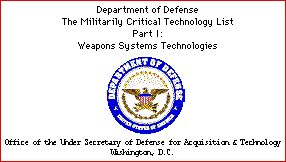
The Militarily Critical Technologies List (MCTL), is a detailed and structured
compendium of the technologies the Department of Defense (DoD) assesses as
critical to maintaining superior United States military capabilities.
[MCTL explanatory citation inserted by JYA]
Source: Department of the Navy document
NOSCINST 5510.4a, 15 August 1986:
***
4. Background
a. The Militarily Critical Technologies List (MCTL) (reference (b)) has been
produced by the Department of Defense in response to section 5(d) of the
Export Administration Act (EAA) of 1979, which states:
"(2) The Secretary of Defense shall bear primary responsibility for developing
a list of militarily critical technologies. In developing such list, primary
emphasis shall be given to-
(A) arrays of design and manufacturing know-how,
(B) keystone manufacturing, inspection, and test equipment, and
(C) goods accompanied by sophisticated operation, application and maintenance
know-how which are not possessed by countries to which exports are controlled
under this section and which, if exported, would permit a significant advance
in a military system of any such country.
(3) The list referred to in Paragraph (2) shall be sufficiently specific
to guide the determination of any official exercising export licensing
responsibilities under this Act."
This document further supports Section 3 of the EAA which states:
"(2) It is the policy of the United States to use export controls only after
full consideration of the impact on the economy of the United States and
only to the extent necessary "
(A) ... .to restrict the export of goods and technology which would make
a significant contribution to the military potential of any other country
or combination of countries which would prove detrimental to national security
of the United States; ...."
b. This instruction concerns technical data with military application: any
blueprints, drawings, plans, instructions, computer software, and documentation
or other technical information that can be used or adapted for use to design,
engineer, produce, manufacture, operate, repair, overhaul, or reproduce any
military equipment or technology concerning such equipment. This instruction
also concerns technology and relevant technical data with significant military
application and included in reference (b), or representing a new technology
or an innovation with significant military importance that should be protected
from public disclosure until it has been evaluated for inclusion in the MCTL.
***
[End citation]
Documents are in Acrobat (*.pdf) Format To view and display these
documents, you need an Adobe Acrobat viewer. Adobe has FREE Acrobat Reader
software available that you can download
for Macintosh, Windows,
MS-DOS and Sun Unix.
Should you have any questions or problems configuring your browser to work
in conjunction with the Acrobat reader, please refer to these
Instructions
MCTL Documents
-
Title Page (PDF)
-
Title Page (GIF)
-
Title Page Back
-
Preface
-
1996 DoD MCTL Master
Locator [JYA site; 32K]
-
Table of Contents
-
Introduction
-
Section 1 - Aeronautics
Systems Technology
-
Section 2 - Armaments &
Energetic Materials Technology
-
Section 3 - Chemical and
Biological Systems Technology
-
Section 4 - Directed and
Kinetic Energy Systems Technology
-
Section 5 - Electronics
Technology
-
Section 6 - Ground Systems
Technology
-
Section 7 - Guidance,
Navigation, and Vehicle Control Technology
-
Section 8 - Information Systems
Technology [below]
-
Section 9 - Information
Warfare Technology [JYA site, 122K]
-
Section 10 - Manufacturing
and Fabrication Technology
-
Section 11 - Materials
Technology
-
Section 12 - Marine Systems
Technology
-
Section 13 - Nuclear Systems
Technology
-
Section 14 - Power Systems
Technology
-
Section 15 - Sensors and
Lasers Technology
-
Section 16 - Signature
Control Technology
-
Section 17 - Space Systems
Technology
-
Section 18 - Weapons Effects
and Countermeasures Technology
-
Appendix A - Glossary of
Acronyms and Abbreviations
-
Appendix B - Definitions
-
Appendix C - Index
-
Appendix D - Explanation
of Table Elements
Source:
http://www.dtic.mil/mctl/data/sec08.pdf
The source PDF file is also on JYA site:
http://jya.com/mcsec08.pdf (305K),
where, if preferred, the figures and tables may be seen more clearly.
SECTION 8 - INFORMATION SYSTEMS TECHNOLOGY
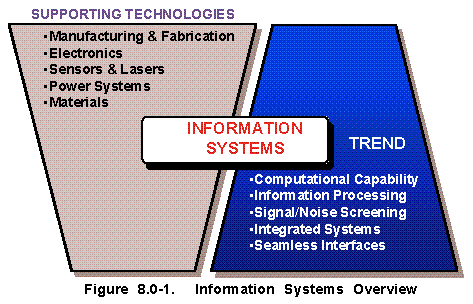
SUMMARY
Overview (See Figure 8.0-1) Information Systems (IS) are defined
as the entire infrastructure, organization, personnel and components that
collect, process, store, transmit, display, disseminate and act on information.
IS include several functional areas: acquisition, organization, and management
of data; processing and manipulation of data; information storage and retrieval;
human-system interfaces; and means for ensuring the reliability and security
of information and system resources. Most technologies used in information
systems are dual use. New technologies and products are emerging daily.
Performance of processors and capacity of memory chips has doubled every
18 months since 1970. This exponential growth is expected to continue until
the year 2005. In addition to technology for the hardware and software components
of reliable and secure information systems, other technology, in the form
of specialized know-how for system design and integration, is necessary to
meet important military requirements for C4I2 , intelligent
systems, modeling and simulation, and strategically essential industrial
CAD/CAM uses. Also, IS are the primary "enabler" and a target for Information
Warfare (see Section 9). The technology areas listed in the box nearby contain
militarily critical technologies. To avoid duplication, specific technology
items are listed under the most appropriate heading in Figure 8.0-2, which
highlights the key dependencies among the technology areas and Information
Warfare.
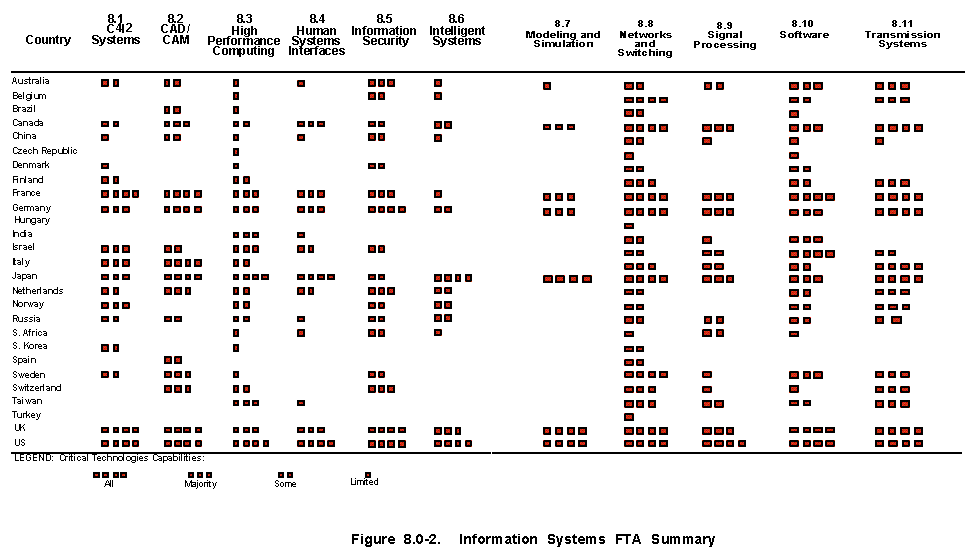
Rationale IS are pervasive in virtually all activities of the
military establishment, the commercial and industrial section, and all levels
of government. IS technologies are vital to US warfighting capabilities.
Uses of IS encompass a range of applications from IS systems embedded in
individual smart weapons and sensors, to local processing and communication
systems, including transportable and personal hand-held devices, to international
wide area networks (i.e., the Internet). Access to these technologies by
potential adversaries could enhance the performance of their military systems
and could also be used to counter US capabilities.
Foreign Technology Assessment (See Figure
8.0-2) The US leads in system engineering and integration of complex
information systems specially designed for military use. The US is closely
followed by the UK, France, Germany, Canada and Japan. The underlying
technologies for IS and for wide area integration of such systems are being
driven largely by commercial infrastructure needs and markets. A significant
number of countries have developed capabilities equivalent to those of the
US in network switching and transmission. The US has sustained its lead in
computing hardware because of superior microprocessor design and fabrication
capabilities (see Sections 5 and 10). While the US continues to be the only
country with critical capabilities in all IS technology areas, equivalent
capabilities are found in one or more other countries in every area. The
growing multi-nationalizaton of information systems developments has increased
the worldwide availability and accessibility of critical technologies. A
high rate of IS knowledge transfer from the US to foreign competitors occurs
through open source US trade journals, technical literature, various
international fora, the Internet, and intelligence. As a result, the US
technology leadership in communications and computer systems has declined
in recent years relative to Europe and Japan. However, the US is the only
country with the ability to supply empirically validated system engineering
and integration know-how to large, complex military systems. This capability
sets the US apart as the world leader.
SECTION 8.1 COMMAND, CONTROL, COMMUNICATIONS, COMPUTING,
INTELLIGENCE, AND INFORMATION SYSTEMS (C4I2)
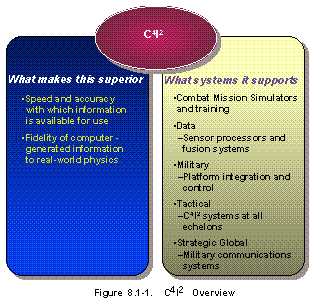
Overview (See Figure 8.1-1) C4I2 comprises
a multi-disciplined set of techniques to provide seamless communications,
information management, and distribution, and decision-making in the new
JCS Vision 20/0, improving situational awareness and effectiveness of warfighting
forces in high-intensity combat situations. C4I2 is
dependent on underlying hardware and software technologies covered elsewhere
in this section. In addition, elements of C4I2 are
also essential for development and operational integration of dynamic training,
modeling, and simulation (see Figure 8.1-2). Battlespace environment has
been explicitly identified as one of DoD's key technology areas for
C4I2 and encompasses the following as key elements:
weather prediction; propagation sensor modeling and performance prediction;
and the underlying information management and human interface technologies
required for effective use. While primarily aimed at military situational
awareness and dynamic training and combat simulation, the technologies in
question will find widespread commercial use in entertainment, education,
and science and engineering.


Rationale (See Table 8.1-1) C4I2 systems
are needed to sustain US forces' superior ability to detect, localize, and
effectively engage enemy forces in a high threat/target-rich environment.
The ability to synthesize and predict the complex effects of weather on sensors,
vehicle maneuver capabilities, and communications gives commanders information
that enhances their tactical decision-making ability. Synthetic battlespace
environments will enable commanders to review the progress and project the
course of battles under existing and predicted conditions; optimize tactics
in real time; rehearse missions; and execute mission plans in real time.
This will provide a level of situational awareness and real-time decision-making
that is essential to sustain the JCS warfighting capabilities (see Introduction,
part A) defined by the JCS in the face of an increasingly mobile and lethal
threat.
Foreign Technology Assessment (See Figure
8.0-2) While the United States leads in C4I2
integration of complete battlespace environment capabilities, other nations
have many of the key underlying elements essential to its development and
operational use. France is a world leader in military communications. The
Army's mobile subscriber equipment (MSE) is, in fact,based on French technology.
Weather prediction, which plays an essential role, is a global activity in
which Canada and the European Union have strong capabilities. Most nations
with active sensor programs also have active efforts to improve their modeling
and simulation of atmospheric effects, including obscurants used on the
battlefield.
SECTION 8.2 COMPUTER-AIDED DESIGN AND COMPUTER-AIDED
MANUFACTURING (CAD/CAM)

Overview (See Figure 8.2-1) Computer-aided design (CAD) is
a technology enabling the design of intricate and often complex devices,
mechanisms, and/or systems. The finished designs have detailed design data
that permit a quality release for parts modeling and manufacturing.
Computer-aided manufacturing (CAM) is a companion technology that supports
the fabrication of a wide variety of devices and mechanisms with favorable
impact on scheduling, flexibility, quality, and costs. The principal users
of CAD and CAM systems have integrated the essentials of both CAD and CAM
into a single, central data base that contains complete repositories of pertinent
design and manufacturing data from which their entire engineering and
manufacturing operations are driven. The ability to build and test computer
models of proposed designs without having to construct expensive and
time-consuming hardware is extremely beneficial to industry. Currently evolving
is a functional hierarchical extension, based on CAD/CAM, that progresses
through Virtual Prototyping, Data Visualization, Visually Coupled Systems,
and Virtual Reality Systems, elements that underpin sophisticated computer
modeling and simulation.
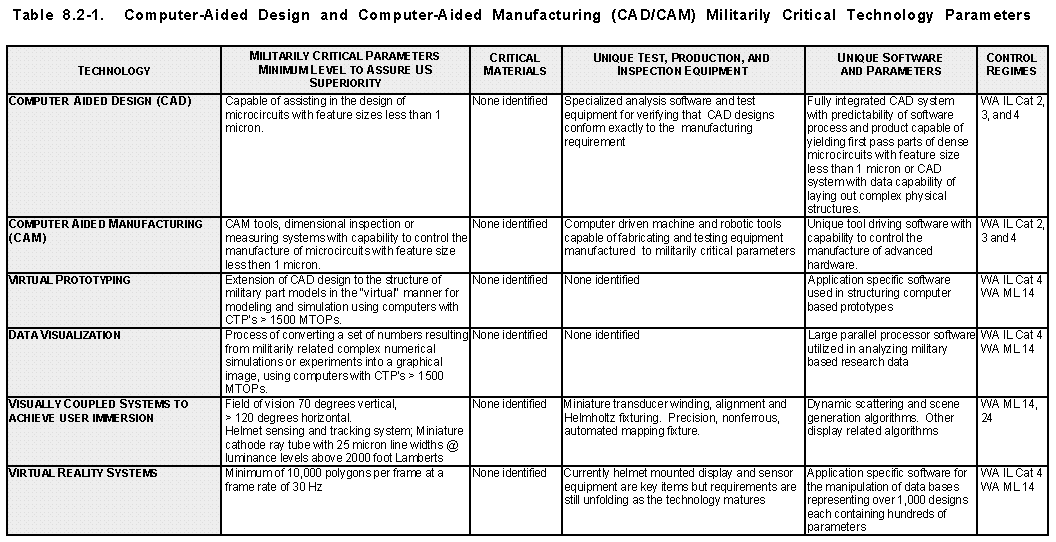
Rationale (See Table 8.2-1) As the complexity and capability
of weapon systems mount, the operating characteristics of a given design
and its producibility must be well-defined and understood before an expensive
build-up program is fully launched. Extensive computer modeling and simulation
has become essential for a wide variety of major military components, such
as ships, submarines, aircraft, surface vehicles, and missiles, and the
subsystems incorporated within them. Because of increased operating cost
and decreasing availability of assets, computer-based simulators are now
used to obtain data that would previously have been acquired through live
operational tests and exercises. Computer-based simulators, employing elaborate
2D and 3D graphic techniques, enable designers to exercise an otherwise
unattainable range and variety of tactical situations. Virtual Prototyping
and Data Visualization are extensions of CAD/CAM and are being used in the
modeling and simulation of a variety of designs requiring high-performance
computers and supercomputers for execution.
Foreign Technology Assessment (See Figure
8.0-2) US industry maintains a dominant lead in the development and use
of CAD/CAM tools. Several NATO nations -- viz., France, Germany, Italy, the
UK, and Canada -- as well as Japan, Sweden, and Switzerland are also active
and effective in the field.
Unique support hardware is normally not required because current systems
depend upon widely available computers and computer ancillaries for operation.
The critical know-how is imbedded in algorithms and software, much of which
is available on the open market. In striving for market edge, major CAD/CAM
users supplement their systems with in-house-developed proprietary CAD/CAM
tools. Military users have benefited from commercial advances. US defense
contractors have been able to adapt CAD/CAM systems, often developed in-house
for commercial use, to fit military design and manufacturing needs. The systems
then become a base for further enhancement. NATO and the Japanese academic
and commercial research efforts have initiated the functional hierarchical
extensions herein mentioned. Military developers have been quick to use the
concepts to produce the sophisticated weaponry modern military requires.
SECTION 8.3 HIGH-PERFORMANCE COMPUTING

Overview (See Figure 8.3-1) High-performance computing encompasses
conventional general-purpose digital computer processing equipment, including
microprocessor-based single and multi-processor systems (including vector
processors, array processors and other computers) and massively parallel
and scalable computing. Also addressed in this section are graphic accelerators
and image generators and programmable interconnections specially designed
for aggregating high-performance processors to increase effective system
power. Computers and software are explicitly identified as key technology
areas in the DoD Technology Area Plans. High-performance computing is also
critical to meet long-range S&T goals for battlefield digitization, human
systems interfaces, manufacturing science and technology, and battlespace
environment. High performance computing is an evolving technology for design
of advanced military systems. (See also Section 8.2, CAD/CAM Technology.)
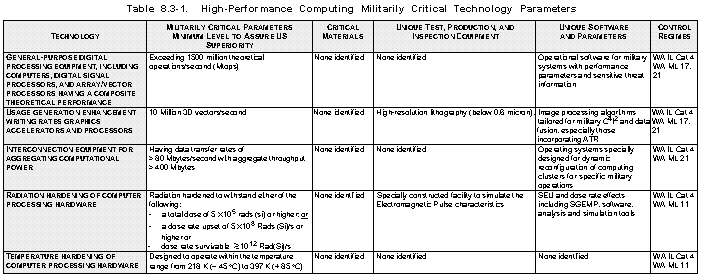
Rationale (See Table 8.3-1) High-performance computing is an
enabling technology for modern tactical and strategic warfare. It is the
principal technological force multiplier that gives US forces their superior
ability to detect, localize, and effectively engage enemy forces in a high
threat/target-rich environment. It is also an enabling technology for processing
the massive amounts of imagery and sensor data for real-time data fusion
and generating synthetic environments for dynamic training and simulation,
mission planning and rehearsal, and operational battle management. Embedded
computers are key enabling elements for improved sensors and smart weapons;
for navigation, guidance, and control of military platforms; and for all
aspects of operational C4I2. Advanced computing is
also important in the development of WMD and represents an enabling technology
for deployment and use of WMD, particularly for CBW delivery, where the problem
of predicting precise patterns of dispersion is computationally demanding.
Access to unique software revealing operational limitations or vulnerabilities
of US systems or to threat information and intelligence sources and methods
might be exploited to defeat or degrade US mission performance. The ability
of recipients to cluster computers on low-cost (~ $3500 per dual port) switching
hubs is a growing factor in setting practical effective lower limits for
proliferation reasons. Such hubs, using a variety of technologies and protocols,
are increasingly being used to network small enterprises to allow more effective
aggregation of processing power.
Foreign Technology Assessment (See Figure
8.0-2) Japan and the US have traditionally shared a worldwide lead in
supercomputers. However, the emphasis in high performance computing is moving
rapidly from mainframes to scalable or massively parallel processor
architectures, in which the US enjoys a lead. The Free World's increasing
availability of technology to support assembly and integration has resulted
in the proliferation of sources for computers up to a CTP level of approximately
700ÊMtops. Other countries capable of assembling military computing
with higher CTPs from widely available, lower performance (less than 700
Mtops) components, assemblies, and computing hardware (predominantly of US
origin) include Germany, the UK, France, Italy, Taiwan, South Korea, and
India.
SECTION 8.4 HUMAN SYSTEMS INTERFACE
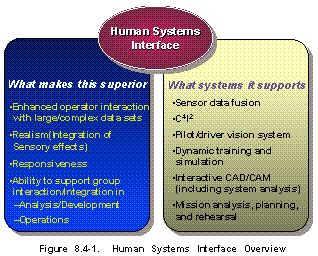
Overview (See Figure 8.4-1) Human systems interface, as covered
in this subsection, encompasses all ways in which human operators interact
with information systems. While the primary interfaces at present are visual
output and manual input, the broader technology area also includes other
forms of sensory inputs including auditory (voice and other audible indicators
and warning), tactile, and haptic devices for both input and output. Human
interface technology is being driven by a variety of requirements, ranging
from those of the entertainment industry to the need to grasp and manipulate
extremely large data sets in scientific research. For two-way communication,
the state of the art remains mechanical (keyboard, joystick, etc.), which
provides an input that is inherently unambiguous. Hands-off input devices
(including eye-tracking, voice input) are being pursued as a way of dealing
with increased workload, without increasing operator stress. Ultimately,
the goal is to achieve total immersion of the operator in a virtual reality
with which he or she interacts in a manner that is perceived as normal.

Rationale (See Table 8.4-1) Significant advances in human system
interfaces are required for circuit and projected military operations in
the high-threat, information-rich battlefield of the future. In combat
operations, two-way human interfaces facilitate an operator's ability to
handle large quantities of information in real time to improve situational
awareness and decision-making capability in periods of high stress. In weapons
systems, they will also improve reaction time and control in tactical vehicles,
particularly in attack helicopters and combat aircraft. While the notion
of unmanned drones for reconnaissance and targeting has been largely accepted
by operational forces, higher fidelity, robust human interfaces will be a
key enabling technology for deployment and use of unmanned engagement systems.
Human system interfaces are also key to the kind of virtual prototyping of
systems and production processes essential to maintaining industrial-base
preparedness and responsiveness.
Foreign Technology Assessment (See Figure
8.0-2) Because of its widespread potential for entertainment mass markets,
several countries have been active in pursuing human system interface technology.
Canada is one of the world leaders in visually coupled, virtual reality
helmet-head-mounted displays. Japan, the UK, and Israel are also active in
this area. Japan's primary emphasis has been on applying the technology to
designing, manufacturing and controlling complex systems and enterprises
(for example very large, distributed electrical power systems). In the last
year, virtual reality has developed as an area of worldwide research, with
strong capabilities also emerging in France and Germany. Israel is reported
to have significant capabilities in military helmet-mounted display and also
has wartime operational experience with unmanned drones that might apply
to human interfaces for teleoperation.
SECTION 8.5 INFORMATION SECURITY
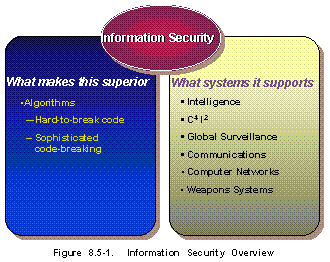
Overview (See Figure 8.5-1) This subsection covers Information
Security technologies whose principal elements are cryptographic algorithms
and cryptanalytic algorithms. These technologies are used by the US military
forces, certain US Government (USG) departments and agencies, and authorized
industrial users. Some special cryptographic systems are shared with US treaty
allies.

[JYA Note: The US has not publicly released its version of Category
5 of The Wassenaar Arrangement (WA Cat. 5 in table Control Regime). Australia
has released its version which may be seen at:
http://jya.com/aucat_5.htm.]
Rationale (See Table 8.5-1) The cryptographic and cryptanalytic
technologies are essential to provide information security for US military
weapons systems and research and development activities and to support essential
USG cryptographic and cryptanalytic functions. Information security systems,
equipment, subassemblies, and components are essential elements of intelligence,
global surveillance, computer and communications networks, and
C4I2 systems that provide reliable wide band communications
links and information management nodes through the chain of command and channels
of communications from the National Command Authorities (NCA) to the warfighters.
Foreign Technology Assessment (See Figure
8.0-2) The US is the largest producer and exporter of telecommunication
and networking equipment and computer hardware and software. Although its
technology leadership in communications and computing systems declined during
the year 1990-1994 period relative to Europe and Japan, the US enjoys increasing
leadership in information management. The imagination and creativity of the
US information system industry and the ability to provide system engineering
and integration of the information security technologies into information
systems are what sets the US apart as the world leader. Information security
technologies and products, especially those that are cryptology based, are
developed independently in both government and industrial sectors by most
nation states. The militarily critical information security technologies
in this subsection are often highly classified by nation states and closely
held by both governments and industries. An accurate assessment of foreign
information security technologies and products is usually not feasible. It
may be possible to infer the state of a country's information security
technologies from the quantity of the commercial information security products
that are offered in world markets. The ranking illustrated in Figure 8.0-2
assumes that a close relationship exists between the state of the art of
the commercial information security products a country offers for sale and
its closely held military technologies and products. The ranking also assumes
that commercial cryptography products are a reliable indicator of a country's
full information security suite of military technologies and products.
SECTION 8.6 INTELLIGENT SYSTEMS
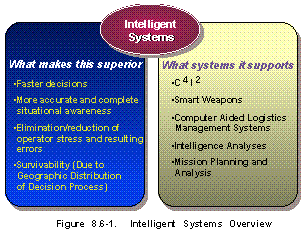
Overview (See Figure 8.6-1) Intelligent systems encompass several
hardware and software items whose ultimate objective is to build systems
that autonomously adapt their functionality&emdash;without human operator
intervention or preprogrammed logic constraints&emdash;in response to changing
requirements and conditions. Intelligent systems can be implemented in software
on general-purpose digital computers or on specially designed analog or hybrid
analog/ digital neural networks and fuzzy logic chips. Interest continues
in high-volume applications (such as in consumer products and appliances),
particularly in the use of fuzzy logic/neural combinations wherein the training
functionality of the neural net is used to optimize the fuzzy logic. Expert
views of what constitutes machine or artificial intelligence have changed
substantially in recent years, with advancing computer technology. Expert
systems, once the predominant type of AI, no longer meet the basic criteria
accepted for machine intelligence and are not considered by many experts
to belong to the field of AI as it is now generally accepted.

Rationale (See Table 8.6-1) The range and lethality of weapons
available to potential adversaries have increased dramatically. Intelligent
systems, in the form of smart sensors and autonomous vehicles and weapons,
have the potential of increasing mission effectiveness while reducing exposure
of human operators. As pilot's assistants, this technology can also reduce
manpower and training requirements, again while maintaining or improving
effectiveness. These same features will also enhance our ability to analyze
military operations in realistic scenarios and conditions for system development,
development of tactics and doctrine, and mission planning and rehearsal.
Finally, intelligent systems are needed as part of battle management and
C4I2 systems to sustain US forces' superior ability
to detect, localize, and effectively engage enemy forces in a high-threat/
target-rich environment.
Foreign Technology Assessment (See Figure
8.0-2) Machine intelligence or intelligent systems are a field of general
worldwide research. Much of this research, however, is still theoretical
and in the area of machine cognition, per se, and not in specific hardware
and software implementations. As noted previously, the growing availability
of increasingly powerful microprocessor-based systems has reduced the emphasis
on the development of special-purpose neural network hardware. Much of what
work is continuing is being done in Japan, specifically in the area of simple
fuzzy-logic/neural net combinations for use in consumer products. Japan is
also interested in dual-use applications, including use of the technology
in helicopter flight controls, that have potentially important military
applications.
SECTION 8.7 MODELING AND SIMULATION
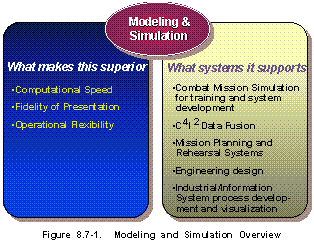
Overview (See Figure 8.7-1) Advanced simulation and modeling
encompasses a wide range of dual-use applications, ranging from engineering
design and manufacturing process optimization to dynamic flight trainers
and simulators to distributed, interactive simulations of entire engagements
and battles. The key elements of this technology involve digital processing
to manipulate the data, human system interfaces through which the users interact
with the data, and the knowledge embedded in the software discussed in related
subsections of this MCTL (see Figure 8.7-2 for cross-reference). The modeling
and simulation technologies are particularly important in the context of
engineering problems and manufacturing processes, where critical know-how
is specific to applications not addressed here.
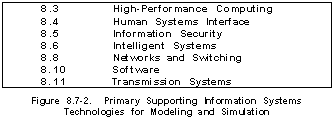

Rationale (See Table 8.7-1) Three considerations drive the
criticality of this technology. The first is force training and readiness.
Decreasing funding, increasing operating costs, and escalating sophistication
of threats and the operational scenarios in which those threats will be
encountered make it impossible to develop essential combat skills in the
field. The second is in industrial base preparedness. One of the effects
of downsizing has been the deferral of engineering and manufacturing development
of advanced systems in favor of extended technology development and demonstration
programs. The risk of delaying engineering and production is reduced directly
in proportion to our ability to do the critical engineering in modeling and
to simulate manufacturing processes accurately. Finally, this technology
plays an essential role in operations, where modeling and simulation will
be critical to effective representation of battlespace environments. In
C3I, modeling and simulation enable commanders to do realistic
mission rehearsal and preparation, explore options, and optimize force
disposition and tactics.
Foreign Technology Assessment (See Figure
8.0-2) France and the UK are among the world leaders in dynamic training
and combat simulation, followed closely by Germany. Japan is a world leader
in most of the underlying technology and is probably the world leader in
distributed interactive simulation of complex enterprises. Canada is also
strong in this technology, particularly in visually coupled systems and dynamic
scene generation.
SECTION 8.8 NETWORKS AND SWITCHING

Overview (See Figure 8.8-1) This subsection covers the militarily
critical technology for telecommunication equipment used for the electronic
transfer of information. It encompasses technologies for
"stored-program-controlled" circuit and packet switching equipment and network
routers used for establishing a communication channel between two or more
points. Switches may be categorized as circuit, message, and packet or any
combination thereof. The technologies found in information networking and
network control are heavily dependent on the automation of the monitoring
and controlling functions within the network. The monitoring and controlling
functions are combined in separate systems, which are capable of working
over a widely dispersed geographical area with equipment using various
transmission media and switches using common channel signaling. These systems
provide a centralized control capability to configure transmission equipment
to optimize networks for loading and failures and to configure switches and
routers to optimize the call distribution within a network. Technologies
identified are optical switching, radiation hardened telecommunications
equipment, and equipment capable of operating in extremely cold and hot
temperatures. Related technologies are multi-level priority and pre-emption;
dynamic adaptive routing; optical switching; and asynchronous transfer mode
(ATM).

Rationale (See Table 8.8-1) Information systems serve as the
vital link in providing current information exchange in the C2
function. The technologies that have provided the classical telecommunication
capabilities have been broadened and have become the vehicle for more
encompassing and capable information systems technologies. While access to
large quantities of information is important, technologies that provide for
the timely receipt of alerting information on enemy status (transmitted even
at low data rates) provide for reorganization of combat battle plans and
response to changing battlefield situations. Effective C2 of forces
is dependent on maintaining continuity of communications at all times with
all elements, fixed or mobile. Continuity can be achieved by switching and
reconfiguring networks to provide alternate means in the event of damage
or jamming in a hostile environment.
Foreign Technology Assessment (See Figure
8.0-2) The majority of the technologies associated with information in
networks and switching are common to both military and civil systems and
have become readily available through joint developments or through foreign
sales. In foreign sales involving technology transfer, secondary transfer
of technology by the original purchaser results in additional proliferation
of this technology. Consequently, many countries have acquired technological
capabilities in this manner and have rapidly improved their own products.
The ranking (which is shown in Figure 8.0-2) largely reflects international
standardization activity. Belgium, Canada, France, Germany, Japan, Sweden,
and the UK have overall capabilities equal to those of the US. US technology
surpasses them in niche technologies such as laser transmission. All of the
foregoing countries plus Australia, Finland and Italy sell switching equipment
worldwide. In most cases this equipment is quite technologically advanced
but usually contains technologies of lesser capability. For example, the
multi-level switching and preemption capability will contain only two levels
rather than three to five levels.
SECTION 8.9 SIGNAL PROCESSING

Overview (See Figure 8.9-1) A signal is any physical quantity
that varies with time, space, or any other independent variable or variables.
Signal processing encompasses all aspects of conditioning, formatting, and
extraction of useful information from such signals. Functions performed by
signal processing include filtering to separate desired signals from undesired
signals (noise) and analysis of the spatial or temporal characteristics of
signals to extract information regarding the content of messages or the location
and identification of targets. Image processing analysis and characterization
of the spatial distribution of signals occur in two or more dimensions. The
patterns generated may correlate to visual images or be entirely synthetic
representations of nonvisual data from multiple sensors. Such 2D signal
processing may or may not also include analysis of the temporal characteristics,
such as moving target imagery.
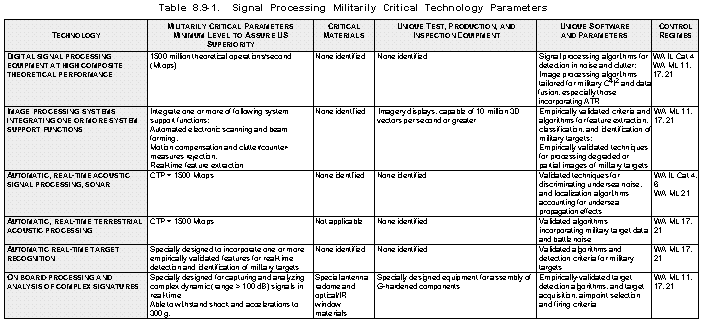
Rationale (See Table 8.9-1) Signal processing is a basic enabling
technology for all telecommunications and military sensors. The ability to
control and exploit the electromagnetic spectrum has become an increasingly
vital element of the electronic battlefield. Signal processing is, in effect,
the first layer of quality assurance for information that will ultimately
be used for decision-making in the battlefield. The accuracy and reliability
of that data, particularly in environments with high levels of interference
(both unintentional and countermeasures induced), is critical to mission
success.
Foreign Technology Assessment (See Figure
8.0-2) The basic principles and, increasingly, the components necessary
for implementing advanced digital processing techniques are increasingly
available. Implementation of militarily critical signal processing functions
rests largely on empirically validated target and engineering design databases
and empirically optimized algorithms. The US, by virtue of many years of
investment in development, test, and operational use of advanced military
sensors, has a significant worldwide lead, followed closely by the UK, France,
and Germany. Japan also has all of the underlying technology elements and
has developed a variety of military systems (IR sensors, mortar location
radars, satellite communications, etc.) that require state-of-the-art signal
processing. Italy, Sweden (airborne radar), and other members of the EU have
capabilities in specific sensor areas, as do Russia, Israel, India, and South
Africa.
SECTION 8.10 SOFTWARE

Overview (See Figure 8.10-1) Software consists of two components:
(1) the applications matters, which contains algorithms, functions or logic,
and parameters and (2) the code, which enables electronic computers to implement
the applications. Militarily critical software applications are included
in other sections of the MCTL as separate technology items or as "Unique
Software and Parameters" in data tables. These applications use validated
software that is generally related to one or more operational or developmental
military systems. This subsection identifies the know-how that makes the
second component, software code, militarily critical. There are two aspects
to code: product and process. As product, code is considered militarily critical
when it meets criteria in Table 8.10-1 under Military Critical Parameters.
Process technologies in the development and life cycle support of software
code -- in such activities as configuration management, testing,
metrics/measurement, integrated documenta-tion, and architecture -- involve
technologies that are not currently militarily critical.

Rationale (See Table 8.10-1) Software code is the lifeblood
of countless models, simulations, decision systems, and information systems
in innumerable military and nonmilitary applications. Attributes by which
code is judged include predictability, reliability, error immunity, and
confidence level. Predictability refers to the degree to which code enables
applications to function as expected (e.g., target damage is, in fact, measured
by a vulnerability model). Reliability is the measure of the code's ability
to enable an application to be executed without interruption. Immunity to
errors covers internal causes (e.g., virus) and external causes (e.g., power
outage). Confidence level is a quantified measure of trust warranted by the
software code. Table 8.10-1 identifies the levels at which these attributes
are militarily critical.
Foreign Technology Assessment (See Figure
8.0-2) Two main considerations in scoring a country's software capability
are (1) the ability to apply software development processes consistently
to large or complex systems integration programs and (2) the ability to develop
code of the quality listed under Militarily Critical Parameters in Table
8.10-1. Besides the US, countries with the best military software capability
are France, Israel, and the UK. Next in capability are Australia, Canada,
Germany, Japan, and Sweden. A great deal of technology exchange takes place
in conferences and publications on software development. The use of the Internet
has also broadened the base of discussion on software development techniques
throughout the world. Currently, the US leads the world, largely because
of national attention and concentration on developing military software.
Other countries have gained expertise in certain aspects of software development,
often from personnel transfers and training by US companies and US universities
or through international conference participation and internationally available
publications. Certain individuals and groups have obtained expertise in hacking
and insertion of "rogue code".
SECTION 8.11 TRANSMISSION SYSTEMS
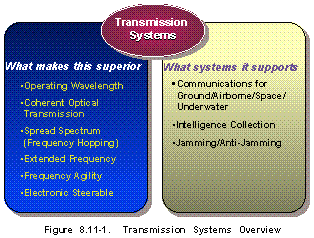
Overview (See Figure 8.11-1) This subsection covers the militarily
critical technology for information transmission equipment and components
used for transfer of voice, data, record, and other information by
electromagnetic means either through atmospheric, exoatmospheric, or subsurface
(water) media or via metallic or fiber optic cable. Information being exchanged
is predominantly in digital form for voice, text, graphics, video and databases.
This facilitates the application of security as required. The majority of
the technologies for telecommunication transmission equipment are common
to both military and civil systems. The information may be analog or digital,
ranging in bandwidth from a single voice channel to video or multiple channels
occupying hundreds of megahertz. Technologies identified as militarily critical
include those for laser communications through atmospheric, exoatmospheric,
and subsurface media or over optical fiber; radio transmission equipment
operating at frequencies > 30 GHz with spread spectrum for low probability
of intercept communications; phased array antennas for beam forming or nulling
of interfering signals; and high-capacity, digitally controlled radio receivers.
Other technologies considered were cable transmission technology for cables
used where reduced vulnerability to intercept is of concern and underwater
communications for concentrated naval operations. The types of cables considered
are single or multiconductor, twisted pair or coaxial metallic cable, and
those using optical fiber conductors. Cables can be employed on the surface
for rapid deployment or buried in the earth for protection or as means of
providing a required degree of hardness. Other applications are underwater
inter-island or intercontinental connections. Technologies identified are
those for single mode fibers with low dispersion; halide-based fibers of
extremely low loss; and components and accessories for fiber.

Rationale (See Table 8.11-1) The technologies for developing
and producing a variety of types of telecommunications equipment used for
electromagnetic transmission of information over any media provide for
information exchange to control forces without impeding their mobility. The
technology used minimizes the probability of information intercept by any
third party. It nullifies the effect of electronic warfare assets that may
be employed by a third party to counter the accurate receipt by the intended
recipient of the information transmitted.
Foreign Technology Assessment (See Figure
8.0-2) The majority of the technologies associated with information
transmission equipment operating in the electromagnetic media or over fiber
or cable are common to both military and civil systems and have been made
readily available in the foreign market or through joint development.
Consequently, many countries have not developed their own unique products
but have acquired technological capabilities incre-mentally as products have
undergone improvement and standardization. The ranking shown in Figure 8.0-2
is based on the information systems produced by the individual countries
and their activity in acquiring or producing products in the world markets.
Six countries -- Canada, France, Germany, Italy, Japan, and the UK -- have
capabilities that rival those possessed by the US. Eight countries -- Australia,
Belgium, Finland, Netherlands, Norway, Sweden, Switzerland, and Taiwan --
have technological capabilities in the majority of the critical technology
areas.
[End Section 8]
Hypertext by JYA/Urban Deadline.


























